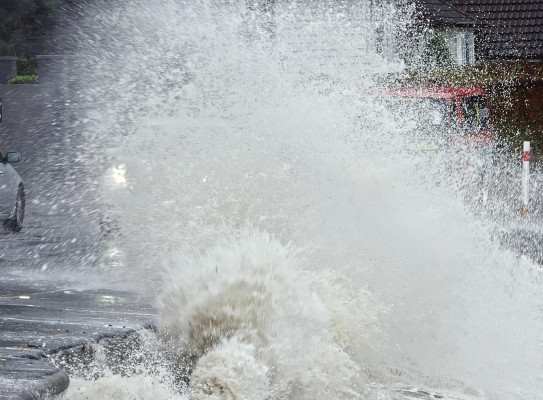Extreme hydroclimate events in New ZealandImproving projections using paleoclimate data

Flood events triggered by extreme rainfall are expected to increase globally with a warming climate. We want to find out more to help improve projections of such events in the future.
Overview
To effectively plan for the future in terms of infrastructure and systems design, MBIE and the New Zealand government need an accurate understanding of the expected magnitude and frequency of hydroclimate extremes. While current models allow for some confidence in the direction of regional change (wetter/drier), and even its “average magnitude”, there’s still considerable uncertainty about these extreme events. Changes in atmospheric circulation can lessen or worsen this effect regionally.
This project will advance the work of three other projects:
- Global Change through Time (GCT)
- Lake Ohau Climate History (LOCH)
- Roosevelt Island Climate Evolution (RICE) ice cores
GCT and LOCH have given GNS Science a large repository of paleoclimate data, including a seasonally-resolved record of flood deposits from Lake Ohau. We will also work on integrating the LOCH and RICE records of change.
The novelty of this project is the introduction of high-resolution climate modelling, integrated with pre-instrumental records of environmental change, using data science techniques like machine learning. This will better accommodate New Zealand’s steep topography.
The project aims to
- deliver a physics-based understanding of the drivers of our extreme hydroclimate events, and how these drivers can change under different climate states
- understand large-scale controls on our hydroclimate extremes, with particular emphasis on decadal-scale climate variability reduce uncertainty in regional flood predictions
- test the hypothesis that our flood frequency is controlled by the IPO and large-scale atmospheric circulation, rather than global mean temperature
To achieve these aims we will
- analyse a 2,600-year sedimentary record of flood frequency from Lake Ohau
- integrate this lake sedimentary record with other paleoclimate proxy records from the Pacific and Southern Ocean and Antarctica
- use this paleoclimate information to improve climate and basin hydrologic model simulations
- join forces with collaborators including NIWA and NeSI (New Zealand eScience Infrastructure)
The project
How does a lake sediment help with past rainfall?
Modern instrumental records are too short to confidently assess the frequency of extreme weather events. In their place, we turn to what are called “Paleoclimate proxy reconstructions”. These include flood deposits in lake sediments, such as those we recovered from Lake Ohau in the South Island.
That sediment record has laminated mud sequences, with seasonal compositional changes associated with summer rainstorm events. Preliminary analysis indicates a high correlation between flood frequency and the Interdecadal Pacific Oscillation (IPO), a 40-60-year variability in Pacific sea surface temperatures (SSTs) that influences large-scale atmospheric circulation and global rainfall patterns.
We believe this sediment record will help address a key debate: do climate models underestimate decadal-scale SST variability in the Pacific, or is there systematic bias in Pacific SST proxy reconstructions?
Is the current model right?
There is scientific debate about whether current climate models are producing the right sort of data on this atmospheric circulation in the Pacific.
We have what’s called the Interdecadal Pacific Oscillation (IPO). This is a 40-60-year variability in Pacific sea surface temperatures (SSTs) that influences large-scale atmospheric circulation and global rainfall patterns.
We need better information that might help us answer two major questions:
- What atmospheric processes caused past extreme rainfall events?
- How will these processes change in a warming climate?
Climate transition and humans arriving in the South Island
Our main interest is the time of transition through the Medieval Warm Period to the Little Ice Age. Two things happened during this time. Flood frequency decoupled from global temperature, in contrast to what is expected from most climate models. The first humans arrived in the South Island, raising two intriguing questions:
- Was migration at the end of the Medieval Warm Period climate-driven?
- To what extent are shifts in flood frequency in the lake record due to land-use change rather than climate change?